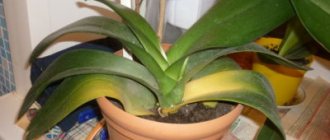Root rot in orchids is observed quite often. This is usually due to the fact that inexperienced gardeners are not accustomed to the special watering regime for phalaenopsis.
A healthy root system of an orchid has a gray-white tint, and after watering it turns greenish. Rotten roots become watery and soft.
In this case, the top layer of roots is easily removed, exposing the inner thread. The surface of diseased roots acquires a brownish-black or brownish tint.
REFERENCE! If the entire part of the root system is intact, and only the tips are damaged, most likely we are talking about burns due to an overdose of fertilizers.
Why does it rot and why is it dangerous?
Root rotting is associated with improper care. Unfavorable conditions lead to the development of fungi and bacteria on the roots. They penetrate the protective shell and destroy internal cells. A slight violation of care and damage to small roots is enough for the disease to begin to spread throughout the entire root system.
If you do not help the orchid, rotting will destroy the entire root system, which will cause the death of the green pet. To save the plant, it is necessary to eliminate the cause of the disease and carry out therapeutic measures.
If the orchid's immunity is weak, rot can completely destroy the roots in a few days. Therefore, when it is detected, treatment measures must be carried out immediately.
Improper care
Rotting orchids can be caused by various reasons:
- Excessive watering leads to deterioration in the respiration of the roots, they die, and rot appears. Gradually, rotting spreads to large organs.
- Lack of sun reduces the plant's need for moisture, which leads to the same consequences as overwatering.
- A dense substrate impairs root respiration, as does excessive watering. Any mixture becomes compacted over time, which leads to rotting.
- A chemical burn causes damage to the root membrane. It is a consequence of an increase in the concentration of mineral fertilizers in the feeding solution.
- Mechanical damage to the roots due to falling or pests causes the death of part of the root system and “opens the gate” to infections.
To save an orchid, it is necessary to remove the cause of rotting:
- move the plant to a bright, safe place;
- reduce watering;
- change the substrate in a timely manner;
- adhere to the dosage when diluting fertilizers.
Otherwise, treatment measures will not help.
Diseases
Fungi and bacteria cause rot, but they only affect plants if the conditions have been violated. Fungal infections are most often associated with overwatering, especially when there is insufficient lighting.
When watering, moisture enters the velamen, but is not absorbed by the exodermis. A favorable environment is created for the development of fungi. Some species take as little as six hours to begin eating away at the root. The mycelium grows throughout all organs of the orchid, penetrating the stem and leaves.
Many spores of fungi that cause decay are around us. They belong to the natural soil flora. Without overwatering, most fungal organisms are harmless. Only excess moisture makes them dangerous.
Causes of root collar damage
Novice gardeners do not know why the roots of an orchid rot. All phalaenopsis diseases are associated with care errors. Hybrids that are resistant to apartment conditions do not withstand frequent violations of agricultural practices. Existing problems are divided into several large groups.
Overwatering
The orchid loves a moist substrate, but does not tolerate constant stagnation of water. Regular swamp causes rotting of the roots, neck and foliage of the plant. At low temperatures, mistakes in agricultural technology stimulate the appearance of fungal diseases. Yellowed bottom plates warn of a problem. Wet growing points are a source of disease spread.
Lack of proper lighting
Plant photosynthesis occurs under the influence of sunlight. Due to a deficiency of ultraviolet light, the orchid slows down its life processes. During this period, phalaenopsis consumes less water, so excess moisture remains in the substrate. If additional lighting is not provided, the roots and neck will begin to rot.
Sunburn is just as dangerous for an orchid as a lack of light. Plants do not like bright directional ultraviolet light after 12 days on a southern windowsill. The error results in yellow spots with a black border on leaves and flowers. If the affected areas are wet, then putrefactive processes increase the volume of the wounds. When neglected, the spots spread to the neck.
How do you know that the rhizomes have begun to deteriorate and that resuscitation is needed?
Problems with the root system affect the entire plant. Root rot can be suspected based on the following signs:
- the leaves turn yellow, become covered with brown spots, become limp and die one after another;
- buds and flowers quickly fall off;
- The stem wobbles a lot when moving the pot.
If these symptoms appear, you need to check the condition of the root system. To do this, the plant is removed from the pot and inspected:
- Healthy roots have a whitish or greenish color and a dense, elastic texture.
- Rotting leads to changes in color and density. The roots become black or brown and easily crush when pressed. If you run your fingers over the root, your hands will become dirty with a black-brown mass, and all that remains of the root will be an inner vein that looks like a thread.
Course of the disease
Different species of orchids are affected by pathogenic fungi and parasites in different ways and under different conditions. Also, the clinical picture looks different.
Pathogenic fungi enter plant tissue due to the presence of certain enzymes. Having penetrated inside, toxins are released, which provoke the formation of rot that decomposes the fabric.
Any, even minor, damage to the roots, leaves or stem allows air to enter the wound and, accordingly, the development of pathogens. Oversaturation with moisture leads to tissue destruction, which is the main culprit in the development of fungal diseases.
Photo
Below you will see what rotten roots look like:
Traditional methods of disposal
In general, only strong chemicals can cope with fungal or bacterial infections. Traditional methods can help if the focus of decay is insignificant and identified at the very initial stage.
Iodine solution
Use as a spray at the rate of: 5 drops of iodine per 5 liters of warm water.
Garlic tincture
Garlic peel in an amount of 100 g is infused in a bucket of water for 20-24 hours . The plant is treated with the prepared, strained solution.
To prepare garlic tincture, only the husk is used.
Mustard infusion
Take 50 g of dry mustard and infuse 5 liters of hot water for 48 hours in a dark, warm place. Before processing, the masterbatch is diluted with water in a 1:1 ratio.
Important! Traditional recipes are not harmful, not toxic, but even with the slightest development of fungal or bacterial infections, they are practically ineffective. You can’t do without chemicals in the fight against rot.
Folk remedies have performed well as preventive drugs.
How to gradually revive a purchased flower that is dying?
How to save an orchid if all its roots are rotten, whether this can be done, and what to do for this, is discussed further. Even if the root system is completely rotten, the plant can be saved. First of all, it is necessary to remove the diseased roots. This is done in several stages.
Substrate removal
- To remove the substrate, the orchid is pulled out of the pot.
- Gently shake the plant until large lumps fall off.
- Residues are removed with water.
Washing the underground part
Before the procedure, the roots are placed in a bowl of water for 10-15 minutes. After this, you can begin the final removal of the substrate:
- The orchid is taken by the stem so that the roots remain in the basin.
- The fingers of the second hand are placed between the roots and gently moved, slightly pushing the woven roots apart.
- Shower off small pieces. To do this, you need to adjust the pressure of the stream so that it does not tear the roots, but cleans off the dirt.
After washing, some roots may still have some substrate left. It cannot be cleaned off by hand. Anything that is not removed with a stream of water is left behind.
Removing diseased roots
What to do with rotting roots? All rotten roots are removed with garden shears or a sharp knife:
- The cut is made on living tissue, at least 3 cm above the lesion site.
- After pruning, the orchid is left in the air for at least 2-3 hours so that the damaged areas heal.
- The dried wound is treated with crushed activated carbon, wood ash or ground cinnamon. This will prevent infection from entering the damaged areas.
After pruning, the orchid can be immediately revived in a greenhouse or in other ways, but it is better to use additional treatment first.
Treatment with growth stimulants
Rotting is always associated with the appearance of a fungus, so before planting, the roots are treated twice, with a week's break. Can be used:
- Tolclofosmethyl.
- Boscalid.
- Pencycuron.
Additionally, succinic acid is added to the solution with each soaking, Epin or Zircon - once every 2-3 weeks.
While antifungal treatment is being carried out, the flower is not planted in the substrate. To prevent the root system from drying out, it is periodically sprayed with a spray bottle. You can add succinic acid to water, 1 tablet per liter of water, it is a natural and safe growth stimulator.
When reviving without a substrate, you can combine root germination and treatment with fungicides and biostimulants.
Types of rot
Gray
A fungal disease caused by the fungus Botrytis cinerea. Ideal conditions for formation are a cold, damp atmosphere with poor air ventilation . Initial appearance on flowers in the form of small brown spots .
As the spots progress, they enlarge and are framed by a pale pink halo . The final phase of spread is the merging of the spots into one and the appearance of gray membranous sprouts (mycelium) of the fungus.
Gray rot on orchids (photo of the back of the affected leaf).
Gray rot on the petals.
Under ideal conditions, an infected plant is capable of releasing spores into the environment. At temperatures from 18 to 23 ° C and humidity of at least 90%, the spread of infection to healthy tissue occurs quite quickly - within 12-15 hours. The most susceptible to the fungus are Phalaenopsis and Cattleya.
Attention! In 90% of cases, a weakened plant is affected.
Brown or bacterial rot
The causative agents are bacteria of the Erwinia, Pseudomonas and others families. Young leaves and shoots are most often affected . Lesions appear as wet brown spots that cover the entire area of the plant before our eyes. If a stem or growing point is affected by brown rot, it dies.
The action of bacteria progresses if the humidity is above 60% and the ambient temperature is 15° and below.
Susceptible to this type of rot:
- Phalaenopsis;
- Cattleya;
- Cymbidium;
- Paphiopedilum.
Bacterial rot.
Another photo of the bakt. rotten.
If the damage is severe, the plants are destroyed. Local, small lesions are cut down to living tissue, and the section is disinfected with crushed activated carbon. Conditions and care are improving.
For preventive purposes, under favorable conditions for the spread of bacteria, spraying is carried out with preparations based on copper.
Black
The causative agents of this fungal disease are soil-dwelling Pitium fungi, which lead a parasitic lifestyle.
And although the main damage occurs to young roots, since they are not yet protected by a reliable coating, when it spreads, it affects all parts of the exotic plant, regardless of age.
The greatest danger is the formation of foci of rot on the root system and at the bases of tuberidia. The danger lies in the rapid spread of lesions to healthy areas. The roots quickly turn black due to tissue necrosis, and the tuberidia become mummified.
The conditions for the spread of black rot are low temperature and high humidity of the environment and soil . Under such conditions, the underground part develops slowly. Some roots do not have enough air in the moisture-saturated soil, and they gradually die off, which makes it easy for pathogenic fungi to penetrate them.
The most accessible black rot are the following types of orchids:
- Cattleyas;
- stangopei;
- laelia;
- leliocattleya;
- paphiopedilum, etc.
Even at normal temperature and humidity, mushrooms do not die . The spread processes slow down and proceed much more slowly. Extensive activation of putrefactive processes leads to the death of the tropical beauty.
Black rot.
You can save the plant in the initial stages of damage . Since development occurs in patches, optimizing moisture and treating with copper-containing preparations will not only significantly slow down the process, but in the early stages can cure ocher.
Dry rot
On orchids, according to some sources, dry rot is nothing more than fusarium. But there is another concept of dry rot - this is southern sclerotial rot.
Southern sclerotial
An infectious disease caused by the fungus Sclerotium rolfsii. It appears on almost all parts , but especially on the roots and stem, and at the same time.
Soil-dwelling fungi that can remain viable for many years. The infection occurs not only with low-quality soil components, but also with irrigation water.
Ideal conditions for propagation are considered to be a temperature of 27-33° C and high humidity.
Southern sclerotial rot.
More photos.
Important! At low humidity, the disease multiplies just as quickly, differing only in a different development process.
If wet rot is in many ways similar to various types of root rot, then dry rot mainly affects orchids growing on blocks.
Fusarium
A fungal disease caused by the fungus Fusarium moniliforme var. Lactis. Spotting on yellowed leaves and their curling is the main symptom of fusarium. The tissues of the leaf blade lose their structure, soften and become covered with a whitish-pink coating formed by fungal spores.
The orchid quickly takes on a dull gray appearance. The central shoot rots and subsequently dies.
Fusarium.
Fighting the disease is quite difficult and takes a long time. For 7-10 days, it is subject to treatment with the drug foundationazol several times a day .
How to care for it to preserve it?
When revived by any method, the plants are provided with ideal environmental conditions: twelve-hour daylight hours, diffused lighting and an air temperature of 20-27 degrees. During the period of root system restoration:
- Reduce the amount of nitrogen in fertilizing.
- If the flower lacks moisture and the leaves lose turgor, they are sprayed.
- Provide regular but meager watering.
In a favorable environment, the orchid will begin to grow roots almost immediately after transplantation. Small flowers will restore the root system in 2-3 months, large specimens will need about six months. Until the plant's health is restored, it will not grow or bloom.
Orchids in nature
All orchid plants according to the structure of the root system are divided into:
- Epiphytic;
- Ground;
- Saprophytic.
Depending on the species of the plant, the substrate necessary for proper cultivation of the plant is selected.
The substrate is selected depending on the type of orchid.
But no matter what type the gardener chooses when purchasing, he needs to know that the root system has the main feature - participation in photosynthesis and fulfilling its main role - feeding the plant with minerals.
Also, for ideal growth, the plant requires high tropical forest humidity, corresponding to its tropics in its homeland.
Growing new roots
The flower takes root if growth preparations are used. The following drugs and substances are used as water additives used to grow roots:
- Ribav-Extra;
- Zircon;
- Radifarm;
- Etamon;
- Fitosporin;
- Kornevin;
- honey;
- sugar;
- any B vitamins.
To improve the condition of the flowers, the leaves are wiped with a solution of succinic acid. It increases immunity, restores vital processes, activates root growth, and stimulates the growth of green shoots.
What to do with it?
Excessive growth of aerial roots is not dangerous if the orchid visually looks good - the leaves are elastic, the color is rich green, the peduncle appears on schedule, the roots are smooth, without signs of disease or drying out.
It is worth taking measures if the plant is not feeling well, including due to a large number of aerial roots. The way out of the situation is to transplant the orchid into a larger container.
The substrate for the flower must be changed once every three years. A good substrate option is moss, charcoal, pine chips in a ratio of 2:1:5. When replanting, it is not recommended to completely replace the soil; you should leave some of the old one. So that the plant survives the move less painfully.
Is it possible to trim aerial or underground roots and is it necessary?
The first thing that orchid breeders need to know is that most species of this plant are epiphytes. Therefore, the plant has two types of roots:
- air;
- underground.
If with the underground everything is more or less clear, then with the air everything is not so simple. An aerial root system is simply necessary for epiphytes. With its help, the orchid is saturated with sunlight and moisture accumulated by these roots.
New roots may appear due to a dry climate. This way the plant increases the surface area through which it intends to absorb moisture.
In this case, you simply need to create comfortable conditions for a representative of the orchid family, that is, increase the air humidity around the plant, for example, by using trays of water.
That is why, if you doubt whether it is possible to cut off both aerial and underground roots, then you just need to remember that this cannot be done unless absolutely necessary. This should only be done if the flower root begins to dry out, die, or rot.
Alive
It is not difficult to distinguish a living and healthy root from a dead one:
- A healthy root is elastic and hard to the touch. With light pressure it does not break or sag. Dead, on the contrary, is dry and shriveled.
- It differs in color from dying roots by a lighter shade. Darkened roots are a sign of beginning death.
- There are no damages, stains or various types of necrosis on the root.
- Tears in the top layer of the root also indicate that such a root will not survive for long. Soon it will die off.
If it was not possible to determine a living root or a dead one by appearance, then you can immerse the root system of the flower in a container of water.
Living roots will immediately take on a rich green color. If this does not happen, the roots are dead. You will most likely have to get rid of them.
Dry dead
You can deal with dead roots in different ways:
- If rotting occurs, such roots absolutely need to be removed.
Rotting is the destruction of healthy roots by putrefactive bacteria. It will no longer be possible to save such a root. In addition, if one of the roots of a flower is rotten, the remaining roots will soon become infected. If infected roots are not trimmed in time, the plant may soon die. - But dried roots, although they will not be able to provide the plant with the necessary nutrition, will not cause any harm to the orchid. Some gardeners leave them to give them greater stability in the pot.
Prevention measures
A rotting orchid is a sad sight. To avoid encountering it, prevention should be carried out.
Effective preventive measures accumulated by the experience of orchid growers:
- comfortable temperature with differences of no more than 5° C;
- humidity 50-60%;
- moderate watering, allowing the substrate to dry out;
- removing water from the leaf axils;
- diffused and sufficient lighting;
- ventilation, avoiding drafts and cold air;
- strict adherence to the rules and concentrations of fertilizing.
Flower growers who decide to grow an exotic plant at home need to remember that a healthy, strong plant with good immunity is practically not susceptible to any kind of disease. Therefore, proper care and maintenance of the required growing conditions is the key to strong immunity and, accordingly, a healthy plant.











